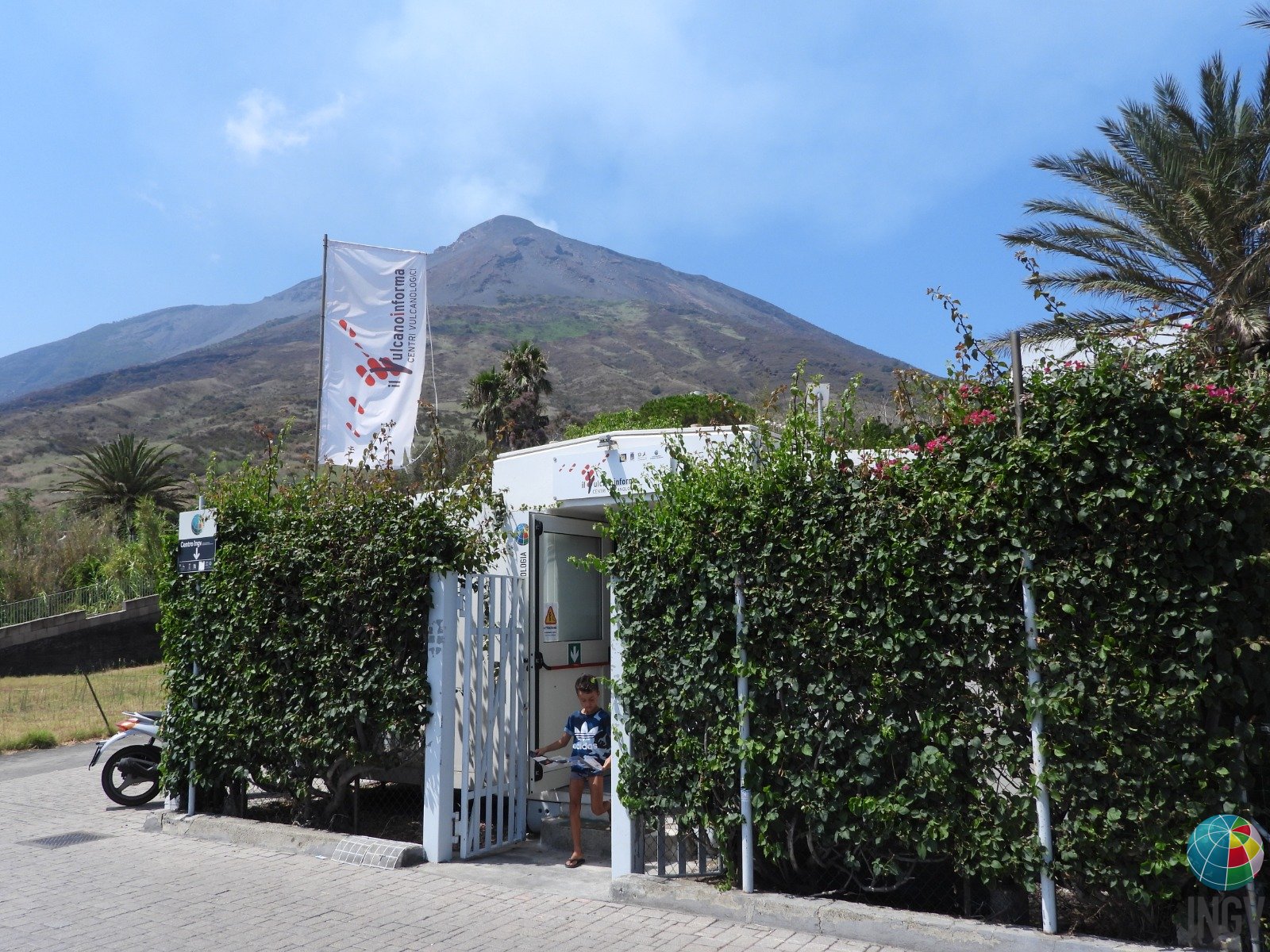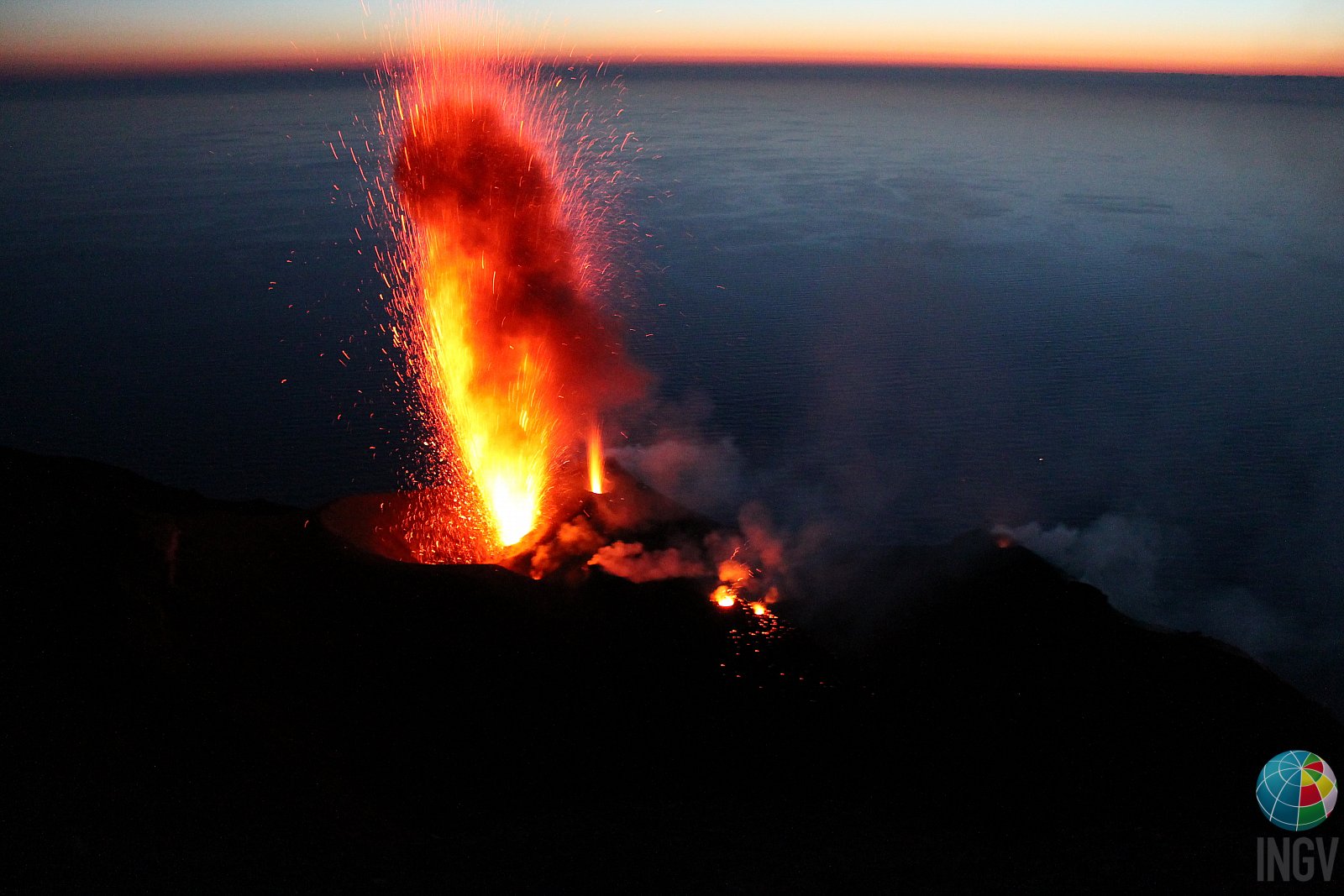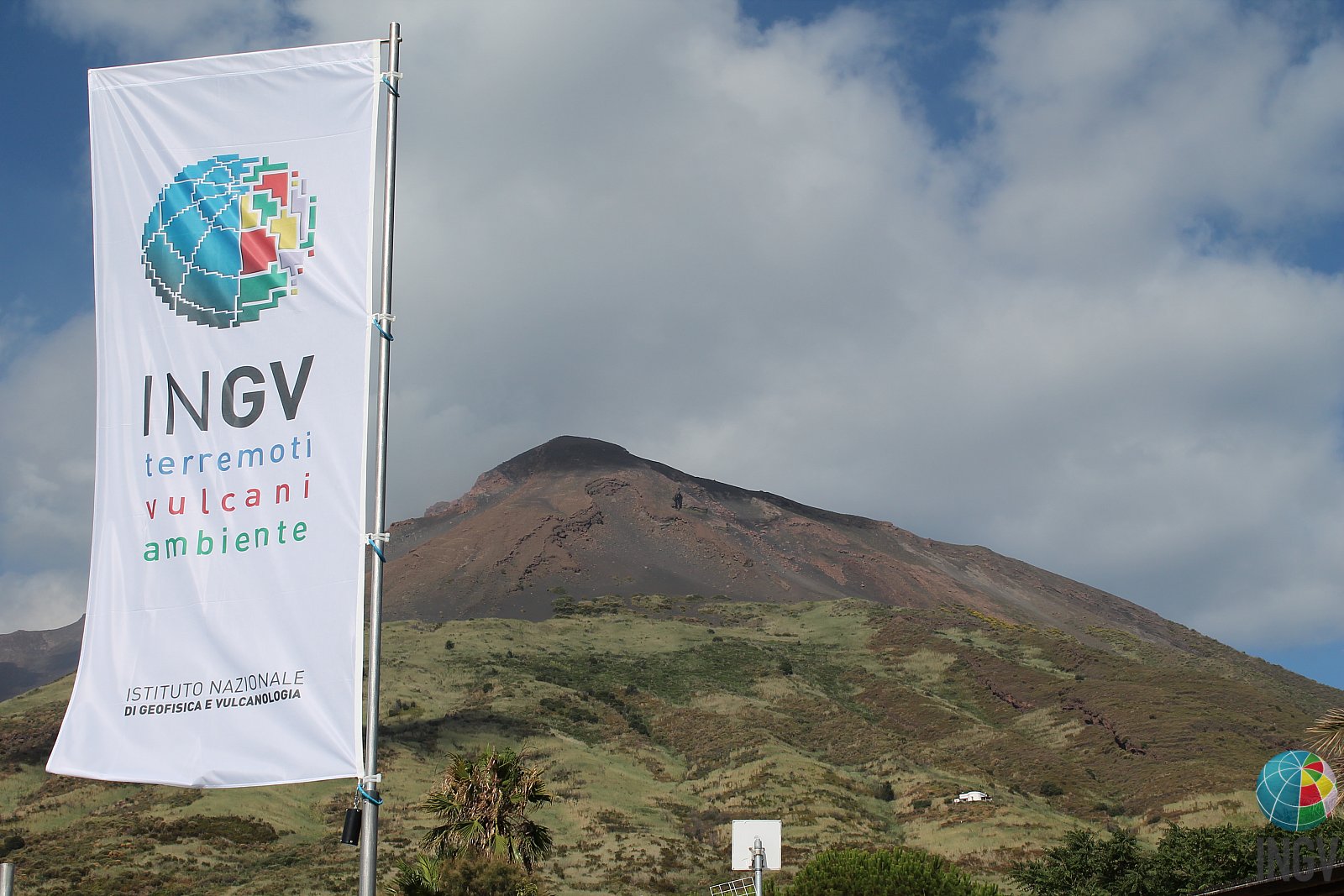L'arcipelago Eoliano è formato da sette isole: Alicudi, Filicudi, Lipari, Panarea, Salina, Stromboli e Vulcano. Di queste, Stromboli è il vulcano più attivo. Per conoscere la sua natura dalla “nascita” alle manifestazioni attuali abbiamo intervistato Mauro Coltelli, vulcanologo dell’Osservatorio Etneo di Catania e Coordinatore del Centro Monitoraggio delle Eolie (CME).
 Mauro, qual è la storia del vulcano Stromboli?
Mauro, qual è la storia del vulcano Stromboli?
Stromboli è il vulcano più settentrionale dell'arco eoliano ed è anche il più attivo.
Da un punto di vista geologico, è legato a un processo di subduzione della Placca Ionica che si immerge al di sotto della Calabria e sprofonda nel mantello fino a oltre seicento chilometri di profondità, rilasciando i fluidi contenuti nella crosta che “riattivano” il mantello sovrastante nella produzione del magma.
Questo magma è di tipo basaltico, piuttosto fluido è meno viscoso rispetto a quello prodotto dalle eruzioni degli altri vulcani eoliani.
Lo Stromboli è caratterizzato da un'attività eruttiva persistente di tipo stromboliana. Il nome di questa attività, tipica di tutti i vulcani basaltici del pianeta, è stato coniato dal geologo Giuseppe Mercalli osservando quella dello Stromboli caratterizzata da piccole esplosioni che lanciano in aria bombe e brandelli di lava e somigliano a dei fuochi d'artificio.
Qual è l’età dello Stromboli?
L’età del vulcano è molto antica: parliamo di oltre un milione di anni per quanto riguarda la formazione sottomarina dell’edificio vulcanico mentre l’attività eruttiva subaerea che ha forgiato la parte emersa è stata prodotta inizialmente da un piccolo cono avventizio che si chiama Strombolicchio a partire da circa 200.000 anni fa. Questo luogo oggi è uno scoglio, un posto bellissimo da cui si può osservare il nucleo del centro vulcanico
Qual è stata l'attività che ha caratterizzato il vulcano nel periodo più recente?
Possiamo dire che l’attività eruttiva subaerea che ha caratterizzato il vulcano negli ultimi 85.000 anni è stata connotata da una continua costruzione e distruzione del cono principale.
A seguito di una serie di eventi, il cono principale si è posizionato più o meno dove oggi sono presenti le bocche eruttive e ha formato il Neo-Stromboli. Quest’ultimo è collassato nel mare formando la Sciara del Fuoco, una depressione all’interno della quale è ripresa l’attività eruttiva prodotta attualmente da una serie di bocche che si aprono su un pianoro chiamato terrazza craterica, che è ciò che rimane dell'antico cratere in parte franato nel mare.
Che tipo di attività possiamo osservare oggi?
La presente attività dello Stromboli è estremamente tipica dei vulcani basaltici ma allo stesso tempo è peculiare in quanto persistente. Questo stato di attività è iniziato più di 1000 anni fa.
L’attività più frequente che possiamo osservare è quella stromboliana caratterizzata da piccole esplosioni che possono raggiungere i 250 metri d’altezza. Si tratta di emissioni di bombe vulcaniche e lapilli da più bocche che riversano questo materiale incandescente che precedentemente si era accumulato all’interno del condotto vulcanico.
L’attività stromboliana è occasionalmente interrotta da manifestazioni più violente che avvengono periodicamente con una frequenza di alcuni eventi l’anno. Tuttavia, con una frequenza ancora più bassa, è possibile osservare eventi straordinari definiti parossismi; gli ultimi sono avvenuti nei mesi di luglio e agosto del 2019.
Le esplosioni che avvengono in questi casi sono più forti di quelle dell’attività stromboliana ordinaria, infatti i prodotti eruttati formano delle colonne eruttive che possono arrivare anche a 8-9 chilometri sul livello del mare e ricadono sui bassi versanti del vulcano e sul mare. In questi casi è possibile che si formino dei flussi piroclastici che scendono rapidamente lungo la Sciara del Fuoco fino al mare, scorrendo sulla superficie marina fino a un paio di chilometri di distanza.
Oltre a questa attività esplosiva abbiamo dei fenomeni di emissione lavica che possono essere di due tipi: l’emissione prodotta dalle bocche sommitali che forma piccole colate di pochi arrivando fino al mare, ed emissioni più complesse, dovute all’intrusione di dicchi all’interno della Sciara del Fuoco, che producono delle fessure eruttive dalle quali il magma esce fuori copioso per periodi anche molto lunghi (molti mesi). Un caso particolare è quello dell’intrusione che si è verificata nel 2003, avvenuta ad una quota talmente bassa da aver destabilizzato la Sciara del Fuoco, in particolare la parte sommersa, che è collassata causando uno tsunami.
Come avviene il monitoraggio di questo vulcano?
Sull’isola di Stromboli disponiamo di un sistema di monitoraggio abbastanza complesso in quanto il tipo di attività vulcanica persistente necessita di conoscere costantemente l'andamento del fenomeno. L’obiettivo che abbiamo è quello di caratterizzare l’attività eruttiva dai parametri geochimici e geofisici monitorati per cercare di capire i mutamenti del vulcano.
A tal fine abbiamo installato una serie di sensori sismici che misurano le esplosioni e stiamo lavorando alla futura installazione di un cavo sismico sottomarino che dalla costa si spingerà fino a circa 1.500 metri sotto il livello del mare per avere informazioni provenienti dalla parte più profonda del vulcano. Portiamo avanti, inoltre, studi di deformazione del suolo con vari strumenti, nonché il monitoraggio di gas emessi dalle bocche e dal suolo. Monitorando questi ultimi, infatti, riusciamo a farci un’idea del percorso dei magma, dalla zona sorgente nel mantello terrestre fino alla zona di stoccaggio ubicata nell’edificio vulcanico sotto la terrazza craterica fino a una quota di circa 450 metri sul livello del mare.
Infine abbiamo a disposizione delle telecamere che rilevano anche la banda termica e con le loro immagini permettono di caratterizzare il tipo di attività e di misurare il numero delle esplosioni.
 Come si chiama l’infrastruttura dell’INGV che coordina il monitoraggio dello Stromboli?
Come si chiama l’infrastruttura dell’INGV che coordina il monitoraggio dello Stromboli?
Il monitoraggio dello Stromboli, così come quello delle Isole Eolie è operato dall’INGV fin dalla sua nascita. Dal 2019, per migliorare la nostra capacità di operare nell’ambito di un sistema di monitoraggio complesso, è nato il Centro di Monitoraggio delle Isole Eolie - CME.
Il CME opera un coordinamento tra i l’osservatorio vulcanologico di Catania, l’Osservatorio Vesuviano e la Sezione INGV di Palermo che si occupa dello studio dei fluidi vulcanici.
Per concludere, qual è il tuo consiglio per chi vuole visitare l’Isola?
La visita di un’isola che ha un vulcano contraddistinto da un’attività sempre presente è un’esperienza unica e affascinante.
Bisogna però tener conto dei rischi legati al territorio perchè l’attività stromboliana può essere interrotta da manifestazioni maggiori quindi è sempre bene trovarsi a una distanza sufficiente per mettersi a riparo in caso di necessità.
Il mio suggerimento è quello di seguire le indicazioni delle autorità di Protezione Civile e godersi il meraviglioso paesaggio.
Stromboli, the charm of the island with an always active volcano
The Aeolian archipelago consists of seven volcanic islands: Alicudi, Filicudi, Lipari, Panarea, Salina, Stromboli and Vulcano. Of these Islands, Stromboli is the most active volcano. To learn about its nature from "birth" to current events, we interviewed Mauro Coltelli, volcanologist at the Osservatorio Etneo in Catania and Coordinator of Centro Monitoraggio delle Eolie (CME)
Mauro, what is the history of the Stromboli volcano?
Stromboli is the northernmost volcano of the Aeolian arc and is also the most active one.
From a geological point of view, it is linked to a process of subduction of the Ionian Plate which plunges beneath Calabria and sinks into the mantle up to over six hundred kilometers deep, releasing the fluids contained in the crust that "reactivate" the mantle above in the production of magma.
This magma is of the basaltic type, rather fluid and less viscous than that produced by the eruptions of the other Aeolian volcanoes.
Stromboli is characterized by persistent eruptive activity of the Strombolian type. The name of this activity, typical of all the basaltic volcanoes on the planet, was coined by the geologist Giuseppe Mercalli observing that of Stromboli characterized by small explosions that throw bombs and shreds of lava into the air and resemble fireworks.
What is the age of Stromboli?
The age of the volcano is very ancient: about over a million years as regards the submarine formation of the volcanic building, while the subaerial eruptive activity that forged the emerged part was initially produced by a small adventitious cone called Strombolicchio starting around 200,000 years ago. This place today is a rock, a beautiful place from which you can observe the core of the volcanic center.
What was the activity that characterized the volcano in the most recent period?
The subaerial eruptive activity of the volcano in the last 85,000 years has been characterized by a continuous construction and destruction of the main cone.
Following a series of events, the main cone was positioned more or less where the eruptive vents are today and formed the Neo-Stromboli. The latter collapsed into the sea forming the Sciara del Fuoco, a depression where the eruptive activity is restarted. The current activity is produced by a series of vents that open onto a plateau called the crater terrace, which is what remains of the ancient crater partly collapsed into the sea.
What kind of activity can we observe today?
The present activity of Stromboli is extremely typical of basaltic volcanoes but at the same time it is peculiar as it is persistent. This state of activity began over 1000 years ago.
The most frequent activity that we can observe is the Strombolian one, characterized by small explosions that can reach 250 meters in height. These are emissions of volcanic bombs and lapilli from multiple vents that pour out this incandescent material previously accumulated inside the volcanic conduit.
Strombolian activity is occasionally interrupted by more violent events that occur periodically with a frequency of some a year. However, with an even lower frequency, it is possible to observe extraordinary events called paroxysms; the latest took place in July and August 2019.
The explosions that occur in these cases are stronger than those of ordinary Strombolian
activity, in fact, the erupted products form eruptive columns that can even reach 8-9 kilometers above sea level and fall on the low slopes of the volcano and the sea. In these cases it is possible that pyroclastic flows form that rapidly descend along the Sciara del Fuoco to the sea, flowing on the sea surface up to a couple of kilometers away.
In addition to this explosive activity we have lava emission phenomena that can be of two types: the emission produced by the summit vents which forms small flows of a few reaching the sea, and more complex emissions, due to the intrusion of dikes inside of the Sciara del Fuoco, which produce eruptive fissures from which the magma comes out copiously for very long periods (many months). A particular case is that of the intrusion that occurred in 2003, which occurred at such a low altitude that it destabilized the Sciara del Fuoco, in particular the submerged part, which collapsed causing a tsunami.
How is the monitoring of this volcano carried out?
On the island of Stromboli we have a fairly complex monitoring system as the type of persistent volcanic activity requires constant knowledge of the trend of the phenomenon. The goal we have is to characterize the eruptive activity from the geochemical and geophysical parameters monitored to try to understand the changes in the volcano.
In this regard, we have installed a series of seismic sensors that measure the explosions. We are also working on the future installation of an underwater seismic cable that will go from the coast to about 1,500 meters below sea level to get information from the deepest part of the volcano. We carry out soil deformation studies with various tools, as well as the monitoring of gases emitted by the vents and the soil. By monitoring the latter, in fact, we can get an idea of the path of the magma, from the source area in the earth's mantle to the storage area located in the volcanic building under the crater terrace up to an altitude of about 450 meters above sea level.
Finally, we have cameras that also detect the thermal band and with their images allow us to characterize the type of activity and measure the number of explosions.
What is the name of the INGV infrastructure that coordinates the monitoring of Stromboli?
The monitoring of Stromboli, as well as that of the Aeolian Islands, has been operated by INGV since its inception. In 2019, to improve our ability to operate within a complex monitoring system, the Centro di Monitoraggio delle Isole Eolie - CME was born.
The CME operates a coordination between the volcanological observatory of Catania, the Osservatorio Vesuviano and the INGV Section of Palermo which deals with the study of volcanic fluids.
Finally, what is your advice for those who want to visit the island?
Visiting an island that has a volcano characterized by ever-present activity is an unique and fascinating experience.
However, it is necessary to take into account the risks associated with the territory because Strombolian activity can be interrupted by major events so it is always good to be at a sufficient distance to take shelter in case of need.
My suggestion is to follow the instructions of the Civil Protection authorities and enjoy the wonderful landscape.


